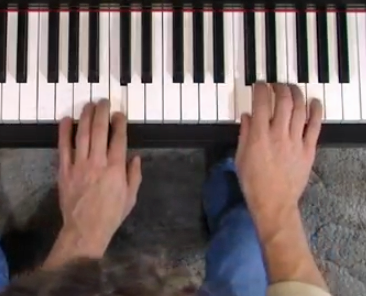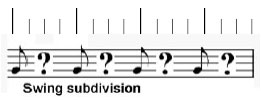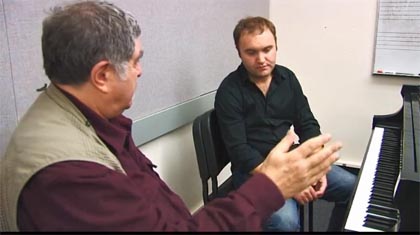« August 2013 |
Main
| October 2013 »
 September 26, 2013 | Artist phrasing
September 26, 2013 | Artist phrasing
Nailing the notes on the fretboard clearly, robust pick stroke, these are important elements of making good music on the mandolin, but they aren't the whole story. There's a conversational aspect of music that even beginners should be aware of once the basics of playing are established. A song is not just a sequence of notes, it's a series of sentences that establish a dialogue between the player and the audience.
To a toddler, you'd point out words that build vocabulary like blue, cereal, nap, and at the early stages of learning the language it would be enough. Soon you'll want to go farther and string the nouns and verbs into instruction and observation to go to that next level of interaction. In music we learn to finger a G and how a quarter note is different than a half note, but when you get into the deeper "poetry" of music, these need to speak on a higher level. That is the essence of what we call phrasing.
Start. Content. End.
Repeat.

This may seem elementary, but it's a common mistake for non-wind musicians like guitar and mandolin, or mallet percussionist to play notes mechanically or worse, "blow" forever and not think of their playing as conversation. Your notes need to be healthy and flowing, but eventually they need to stop and start a new thought. Despite the use of a sustain pedal, piano players are often guilty of poor phrasing, and it's from the front end--the attack and the way the notes are connected.
The following "Piano-ology" video with Frank Peter is a good introduction to this.
Enjoy:
How to Play Like an Artist: An Introduction to Phrasing
Video Link: Further
Thinking in Sentences
Compose yourself. Story Arcs
Forsaking the notes for the music.
Real Swell...
Posted by Ted at 1:29 PM
 September 19, 2013 | Don't mean a thing. If it ain't...
September 19, 2013 | Don't mean a thing. If it ain't...
The perpetual question, "How can I swing?"
The short answer has always been a subjective and not entirely complete, "listen, listen, listen," but we'd like to suggest there are also concrete practical principles to consider. Yes, you want to listen to great music. Immerse yourself in the jazz giants, but while you're doing this, consider three aspects of rhythm you'll want to copy and assimilate into your playing, shuffle, articulation, and drag.
Shuffle. In an early (June 2005) MandolinSessions article outlined how we divide rhythms, and if you have never read this, it's worth the time. There is also an accompanying exercise to help you get your groove on, go back: "On the Up and Up: Jazz articulations." We talked about division and subdivision, divining a beat into halves (duple) and thirds (triple), and further subdividing, complete with a visual map of note placement:

Our conclusion was that in variations of true swing, you would find the divided beats in different degrees of shuffle. A good demonstration of this is to place your hands together in "prayer" position. Now rub the palms in motion, counting 1 & 2 & 1 & 2&, etc. (count out loud, too). Now do the same as if you were counting triplets 1& duh 2 & duh 1& duh 2 & duh (keep the same tempo) alternating on the 1st and 3rd division). Go back and divide in half again, and after you're set, move into the triple. Alternate between the duple and the triple. As you get comfortable doing this, try variances of something in between the two feels. Now go listen to your favorite swing music and try to feel which of the two, duple or triple the music is. What you'll find at various tempos, the subdivision is somewhere in between. If you're rubbing your palms in even thirds, it sounds terribly sterile; if your dividing in half, even worse.

When drum machines came out in the mid 1980's, many models included a "shuffle" slider or knob that would allow you to tweak the feel somewhere in middle of duple and triple. It's the dirty little secret of "Hip Hop" studio production (such an oxymoron...), dialing into that magic feel, and sustaining it metrically through the song. It didn't sound "machine-like" because the brain struggles to comprehend what the division is.
Articulations. Mandolinists particularly struggle with a good swing sound for two reasons, 1.) the limited sustain of our plectrum treble range and 2.) the fact that every articulation is struck hard with a pick. Mandolin is not like a sax that can "Fooh Fooh" or "Thudt Thudt," tonguing into a note to varying degrees. We have one articulation, and it's either on or off. This means we work a little harder than our wind brethren to communicate swing. In addition to making sure our phrases are linear and well sustained, the best thing we can do is develop a rich upstroke. The MandolinSessions article mentioned prior goes into this in more detail, even offering an exercise to make yourself conscious of the need for a healthy upstroke. Think Frank (Sinatra). Doo BEE Doo BEE Doo...
Drag. Note, this is different than "shuffle." Sure you drag the upbeats to a certain point, but you can also drag an entire section of notes. Leave the meter and breathe some human-ness into your improvisation.
Say you have a triplet pattern; try delaying each of the notes ever so slightly. Real swing musicians don't play in the box all the time. You need a good sense of time always, but that's internal (and held up by a good rhythm section or accompanying instrument). Don't lose track of where the beat is, but play around it.
This swing stuff is so subjective, but you can still listen and develop tricks that you'll inject into your playing and improvising.
Further:
Swing Hard. Pick Well.
It's a drag...
"On the Up and Up: Jazz articulations.
Hipsters, flipsters, and finger-poppin' daddies
Posted by Ted at 12:15 PM
 September 12, 2013 | Best of JM: Compose yourself. Story Arcs
September 12, 2013 | Best of JM: Compose yourself. Story Arcs
Enjoy the popular archive material below.
From July 1, 2010 | Compose yourself. Story Arcs
The second in our series on "intentional" improvisation (Antecedent/Consequence last week) holds interesting concepts parallel to dramatic writing or screenplay, the notion of the Story Arc. Simply put, you start with something serene, introduce chaos, and through the course of the script, bring things to resolution.

Of course within that big picture, you have the more intricate details of subplots and character development, but still the best writers glue all these pieces to a great big mental story board. Boy meets girl, falls in love, has to fight for her attention, boy marries girl. Within that narrative is a myriad of twists and turns, the parents are against the idea, the boy can't shape the emotional baggage and behavior-shaping of a bad childhood, a hurricane threatens to destroy the town. These are all the diversions within the larger whole.
So what elements in music do we have that create similar twists and turns when our soloing needs to recount? When you are building your improv, you can certainly use the components of gravity notes and chord tones for the "subplots" of the music. The 4th and the 7th scale degrees, the surrounding chromatic passing tones leading to chord tones, all the melodic tension we cover in music theory can bring those moments of harmonic drama. This is the "character development" of the line.
Note frequency is something to consider. The worst thing you can do is come out of the gate and immediately unload machine-gun style, all your best rapid-fire licks in the first few phrases of your solo. You need that audience "foreplay" to get them warmed up to your musical ideas, plus you don't want to save your least interesting materials for last. Build by starting with slower notes and lots of Miles Davis inspired space. Save the thick black notes energy for the middle or towards the end of your solo.
Register shifts can be a fresh way to tell a story, and it's very graphical on the fretboard. Sure you want to bounce around the frets, but for heaven's sake, the mandolin can be a very shrill instrument, and dwelling up above the 12th fret can be hard on the ears. Save it for "punctuation," spice, and energy.
Dynamics are a no-brainer. Make your softs softer, your louds louder, and find the colossal range of nuance in everything in between. Remember you draw people in by playing quietly, you pound on them playing loudly. They only want so much decibel abuse and they can start tuning you out. Dynamic variety equals sophistication.
Lastly, use recurring themes and motif tidbits. We mentioned this last week about developing antecedent/consequent phrasing. Start with a simple idea and play with it, a scene and keep coming back to it, develop it. Don't just blow.
Nobody likes a drama queen when she's overly dramatic, unintelligible, and narcissistic. Spin a clear story that works the audience, not just yourself.
Further:
Compose yourself. Antecedent/Consequent thinking
Forsaking the notes for the music.
You may quote me on that.
Sitting on the edge of their seats
Dynamic Results
Posted by Ted at 8:16 AM
 September 5, 2013 | Driving sound. From the back.
September 5, 2013 | Driving sound. From the back.
Should the mechanism drive the music or the other way around?
The Hal Galper lesson below is a fascinating look at the concept of how we should let the instrument dictate the musicality of phrasing. Decaying overtones over the fundamental and how they change over time is another view at music production. Like piano players, we focus on articulation, in our case, it's pick technique we hone in on, but Galper has a fascinating approach to manipulating the swell and decay of the sound.

We've advocated the importance of tone being what goes on between notes, and this is another way to describe this phenomenon. As you dig deeper into the video, you'll see how attention to these details translate into the bigger picture of line and ultimately, feel.
In your practice, try to change your thinking from the way the note starts to the way it ends. Especially when you play fast, you don't want to just "skate" the notes.
Video link: Hal Galper's Piano Lesson

Note: video excerpt starts in the middle. The earlier section is great, too.
Further:
Blowing through the phrase
Using the picking hand to start Good Tone.
Three Four Pull: Foregoing the Fourth Finger Frack.
What the Pros say about Good Tone.
The Virtues of Sustain
Posted by Ted at 9:44 AM

Disclaimer: In the 'Information Age' of the 21st Century,
any fool with a computer, a modem, and an idea can
become a self-professed 'expert." This site does not
come equipped with 'discernment.'
|



